At The National Archives, before a historical document is digitised, it passes through a team of conservators to ensure that it is fit for scanning. This ‘stamp of approval’ requires that all information contained within the document be legible and that any damage be repaired so that it may be safely handled.
Within a mass digitisation project of records from the Colonial Office, in commercial partnership with Adam Matthew Digital, I found a large bound book comprised entirely of oversized foldout pages in a highly fragmented state. Damage was so extensive that it could only be viewed under supervision of a member of our Collection Care department. There were numerous tears and creases, most pages were not intact and hundreds of mismatched loose fragments were haphazardly spread throughout the book.
The book, CO 5/509, is a record of shipping returns to ports in South Carolina between 1721 and 1735. The build and ownership of each vessel are registered, as well as its provenance, destination and an inventory of its cargo. Besides the importation of a wide range of material commodities such as food, alcohol, animal skins, elephant tusks and planks of wood, the record also holds testament to slave trade practices, with slaves being brought by the hundreds from Africa – particularly Angola and Guinea – and in significantly smaller numbers from the Caribbean.
Due to the extent of fragmentation of the book’s pages, this information was largely inaccessible and it was impossible to discern whether any fragments (and hence information) had been lost. Under no circumstances could the book be digitised in that condition.
Treatment
Thanks to the hard work of our record specialist Ruth Selman, the book was sorted before treatment: all fragments were successfully reunited with their respective pages. Surprisingly, very few fragments of paper were missing, and mostly only in small areas.
The document then came to Collection Care, where I painstakingly reattached the hundreds of fragments.
Here are two examples of pages before and after treatment:
- Page 66 before treatment, in eight fragments
- Page 66 after treatment
- Page 145 before treatment
- Page 145 after treatment
After almost 40 hours of work – an unusually extensive time frame for a treatment carried out by the digitisation team – the information in the book was made accessible and it was sturdy enough for handling, allowing it to be safely digitised.
It was truly a pleasure to accompany the gradual journey from random disarray to a unified and usable document. Thanks to successful collaborations – both within The National Archives and with Adam Matthew Digital – this book can now be widely consulted and appreciated.
- Bound volume before treatment
- Bound volume after treatment
For more information about these records (CO 5 series), visit Adam Matthew Digital and Discovery, our catalogue.
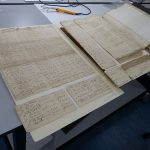
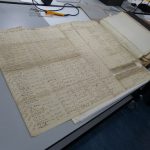
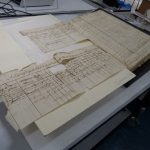
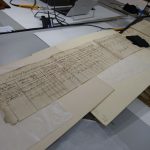
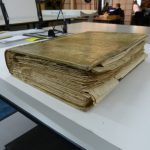
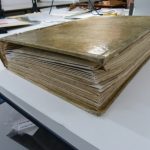
I am a PhD student. My subject : is Anjengo (Trivandrum, Kerala), a settlement of British. So pls help me to collect details during that period of Anjengo relations and all relevent materials Photographs from other sides of the country and from abrode.
Hi Anilkumar,
Thanks for your comment.
We can’t answer research requests on the blog, but if you go to our ‘contact us’ page at http://nationalarchives.gov.uk/contact/ you’ll see how to get in touch with our record experts by email, live chat or phone.
Best regards,
Liz.